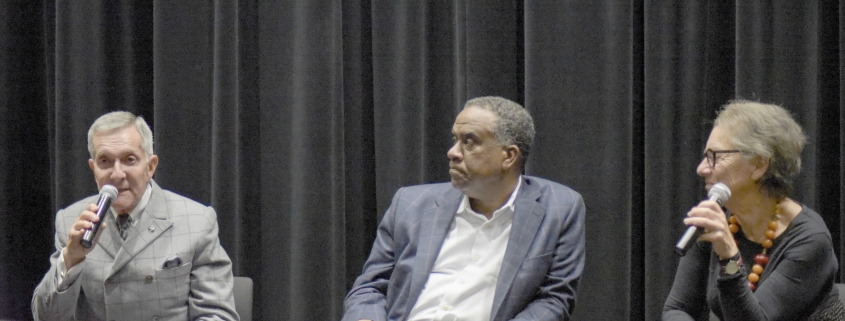SCA decides against fully removing Wayne exhibit

(Andrea Diaz | Daily Trojan)
The School of Cinematic Arts announced Wednesday it plans to keep its John Wayne exhibit but transform the space to represent the complex narrative of the American West at a panel discussion, titled “Examining Yesterday’s Culture Through Today’s Eyes.” In October, students protested the exhibit, which has come under fire from those claiming that Wayne was a problematic figure.
Ultimately, the school decided not to remove the exhibit but rather to transform the space into a more complicated story about the American West in cinema. Each display case will be reimagined with elements of Indigenous filmmaking, feminism and critical race theory through interactive displays with the intention of facilitating viewer discussion.
The largest case in the center of the exhibit will be removed altogether to allow for more open space for visitors to convene.
Freshman film and television production major, Samuel Holley, agreed with SCA’s decision regarding the Wayne exhibit and said the message of adding depth to the narrative resonated with him.
“Rather than just taking the entire thing down, I think renovating it and repurposing it to something more inclusive and all-encompassing of the Western genre that represents marginalized groups while also not shying away from the darker history is a very good move on SCA’s part,” Holley said.
The panel featured three museum industry professionals, including W. Richard West Jr., Selma Holo and George Davis. They each spoke about their extensive experience and personal opinions regarding the cultural significance and social importance of exhibits that reflect history.
Director of the USC Fisher Museum of Art and art history professor Selma Holo pressed the importance of transparency in museum culture and curation.
“We have to be [transparent], whether we are the makers of these shows, exhibitions and museums, or the visitors, because people like me are both […] we have to call it. We have to say ‘this is unfair, it’s unjust, it’s colonializing, it’s whatever it is, and I don’t think we can expect any museum to be perfect. We do, however, more and more, have the right to expect them to be transparent,” Holo said.
SCA received extensive backlash for the exhibit from USC students and alumni, as well as the general public. Given the immense outreach, the school has facilitated numerous discussions with SCA students and industry experts to decide on the best plan moving forward.
Eric Plant, a junior majoring in fine arts who created a banner protesting the exhibit, told the Daily Trojan in September that because of Wayne’s controversial stances and portrayal of Native Americans in film, he is “a blatant racist.” He said the actor promoted the genocide of indigenous Americans in his films.
“By keeping Wayne’s legacy alive, SCA is endorsing white supremacy,” the banner read.
Wayne attended and played football for USC before becoming an actor but is controversial for his stance on the treatment of people of color and indigenous people throughout history.
The Wayne Collection exhibit, which features a statue of Wayne along with several of his personal items in glass cases, was dedicated in June 2012. The collection contains a variety of Wayne film posters, memorabilia, awards and letters.
Davis has led the California African American Museum since 2015. He said he uses his previous experience in the entertainment industry to focus on adapting museum culture and context for younger generations. He does this by refining the museum’s mission to showcase art, history and culture in new and innovative ways, he said.
“When I took over, my concern was that, especially if you’re culturally specific, whether it’s a Jewish museum, a Chinese American, Japanese, you’re trying to satisfy all aspects of the community,” Davis said. “We just got to a place, when I took over, that we really felt it was hard to do that and we just decided we really needed to be a museum much more for younger people. So we went through a process of really everything.”
Richard West, a citizen of the Cheyenne and Arapaho nation, is the president and CEO of the Autry Museum of the American West and has an extensive background working in the national and international museum communities. He has also worked as a lawyer advocating for indigenous rights before Congress and federal and tribal courts.
West sees museums and exhibits as environments and spaces for conversation rather than pure display. He discussed his experiences working for various museums and stated that museums today must not operate in the same way as in previous centuries.
“I happen to think they are not simply houses of objects,” West said. “They are something very different, I think, in the 21st century. They need to strive to be gathering places for conversation, debate, consideration, even controversy. But safe places for unsafe ideas.”

